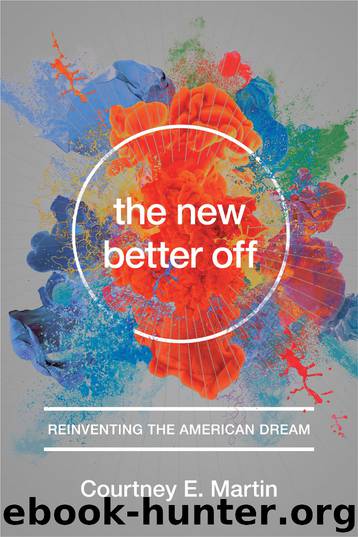The New Better Off by Courtney E. Martin

Author:Courtney E. Martin
Language: eng
Format: epub
ISBN: 9781580055802
Publisher: Seal Press
Published: 2016-08-26T16:00:00+00:00
FREEDOM NO LONGER BUILT BY FORD
There is an image of my parents that is permanently tattooed on my brain: my mom leans into my dad’s right side as his long arm stretches around the back of her beautiful shoulders. His left hand is on the metallic mint-green steering wheel, his fingernails squat and clean like always. My mom’s burgundy hair is in a haphazard ponytail. The fuzzy dice swing from the rearview mirror. All is right in the world.
My dad got his first car in 1964—a ’55 mint-green-and-yellow Chevy convertible for $550. He bagged groceries in Denver, Colorado, in order to afford it. He wanted the car for a lot of reasons. For one, it was cool. My dad was on the bowling team and the newspaper staff—enough said. But there was something even more fundamental about it. “The Chevy was always freedom to me,” he told me. His own family was chaotic and fragile. A Chevy convertible was the exact opposite—built like a steel boat and ready to go anywhere, anytime. He fantasized about sailing into the sunset with his high school sweetheart by his side. With a car like that, life would be different.
My dad wasn’t the only teenager lusting after steel and wheels back in the sixties. It was a time of suburban entrenchment. After World War II, the creation of Levittown was the symbolic beginning of a vast expansion of “bedroom communities.” Being more spread out meant building more highways (in 1956 the Federal Aid Highway Act connected all the major cities in the U.S.). Cars weren’t just the way to get from here to there—they were the ultimate status symbol. The Beach Boys, Jan and Dean, and Ronny & the Daytonas all belted out popular hits about the beauty and danger of these quintessentially American machines.
Now, they just don’t make ’em like they used to. Or, more accurately, they just don’t make us swoon like they used to. Cars today hold a completely different place in the cultural imagination of the American public, and there are real environmental and economic consequences to that. In a piece in The New York Times fatalistically titled “The End of Car Culture,” Elisabeth Rosenthal writes: “The United States, with its broad expanses and suburban ideals, had long been one of the world’s prime car cultures. . . . But America’s love affair with its vehicles seems to be cooling.”14
She goes on to cite a wide range of factors. The rise of the Internet has increased both telecommuting and the number of people who commute via public transportation. (Who wouldn’t rather be scrolling through Instagram photos than grinding her teeth in gridlock?) For those who do commute, there are car-sharing apps and company-sponsored buses that shuttle employees from hip city centers to office parks farther afield. Though it’s true that Americans drive fewer miles and buy fewer cars in part because of the economic downturn, the trend was on the rise even before 2008.15 For one thing, in our increasingly interconnected world, we don’t need to get into our cars in order to see people face-to-face.
Download
This site does not store any files on its server. We only index and link to content provided by other sites. Please contact the content providers to delete copyright contents if any and email us, we'll remove relevant links or contents immediately.
| Anthropology | Archaeology |
| Philosophy | Politics & Government |
| Social Sciences | Sociology |
| Women's Studies |
Cecilia; Or, Memoirs of an Heiress — Volume 1 by Fanny Burney(32061)
Cecilia; Or, Memoirs of an Heiress — Volume 3 by Fanny Burney(31456)
Cecilia; Or, Memoirs of an Heiress — Volume 2 by Fanny Burney(31408)
The Great Music City by Andrea Baker(30780)
We're Going to Need More Wine by Gabrielle Union(18631)
All the Missing Girls by Megan Miranda(14730)
Pimp by Iceberg Slim(13777)
Bombshells: Glamour Girls of a Lifetime by Sullivan Steve(13683)
Fifty Shades Freed by E L James(12912)
Talking to Strangers by Malcolm Gladwell(12871)
Norse Mythology by Gaiman Neil(12826)
For the Love of Europe by Rick Steves(11463)
Crazy Rich Asians by Kevin Kwan(8886)
Mindhunter: Inside the FBI's Elite Serial Crime Unit by John E. Douglas & Mark Olshaker(8699)
The Lost Art of Listening by Michael P. Nichols(7159)
Enlightenment Now: The Case for Reason, Science, Humanism, and Progress by Steven Pinker(6871)
The Four Agreements by Don Miguel Ruiz(6317)
Bad Blood by John Carreyrou(6275)
Weapons of Math Destruction by Cathy O'Neil(5829)
